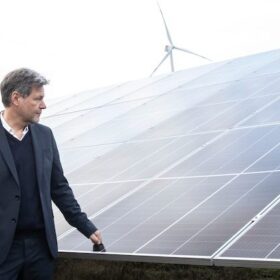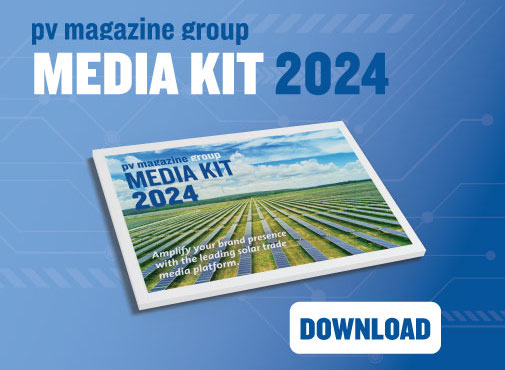Top News
Data center power loads threaten corporate net-zero goals

The Hydrogen Stream: German government adopts import strategy to create investment security

Livoltek commissions inverter factory in Brazil
Now live: www.ess-news.com
MEDIA KIT 2024

Portugal launches first auction for green biomethane and hydrogen

Germany accelerates approval procedures for PV, wind power, storage
Insolation Energy to add 3 GW solar panel, 1.4 GW cell capacity by March
Colombia: 922.8 MW of PV projects under construction
EWEC issues requests for proposals for 400 MW BESS project
Press Releases
GoodWe’s Galaxy Panels: The No-Penetration Solution for Concrete Roof Integrity and Leak-Free Solar Technology in Gold Coast
LONGi Completed Its First Vertical Installation of All-Black Solar Modules in Japan
The 10GW High-efficiency Module Project at DAS Solar’s Jingshan Base Began Full-scale Productio
WEIHENG ECACTUS Ranked by BloombergNEF as Tier 1 Global Energy Storage Manufacturer
Opinion & Analysis
Featured
‘Being a woman in solar is about more than creating your own career’
Year-to-year solar variability peaks in Europe, Australia, Argentina, and China
In a new weekly update for pv magazine, Solcast, a DNV company, reports that the regions with the highest year-to-year variability in irradiance include Central and Northern Europe, East Coast Australia, Northern Argentina, and China, with Africa exhibiting the most stable irradiance year-on-year.
Wafer prices near bottom, size evolution and capacity globalization continue
In a new weekly update for pv magazine, OPIS, a Dow Jones company, provides a quick look at the main price trends in the global PV industry.
China’s solar dominance not an issue
In a new monthly column for pv magazine, the International Solar Energy Society (ISES) explains why potential trade disruptions in the global PV supply chain are substantially different from those related to coal, oil and gas.
Leasing models could help German solar installers cope with falling panel prices
Martin Schachinger, the founder of pvXchange.com, explains how German solar installers are navigating the current slide in PV module prices – now as low as €0.08($0.09)/kW. He says that solar leasing could offer new opportunities, particularly in the nation’s commercial and industrial (C&I) sector.
‘Scarcity of female peers, role models can lead to isolation, lack of natural allies’
This week, Women in Solar Europe (WiSEu) gives voice to Camille Zimmermann, Investment Director at France-based equity firm Omnes. She says that, when there are women at the helm of companies, it seems there is no problem in finding other talented women to join the ranks of their organizations.
Markets & Policy
Work underway on Lightsource bp’s 560 MW solar project in Greece
Liberia seeks consultants for 20 MW solar project
Liberia Electricity Corporation is searching for consultants to support the construction of a 20 MW solar plant, to be located alongside an existing 88 MW hydropower facility.
Enel Chile begins commercial operation of its largest hybrid project in the country
The PFV Las Salinas stages 1, 2 and 3, which totals 205 MW, will operate jointly with the 112 MW Sierra Gorda Este wind farm and will be the largest industrial-scale hybrid renewable generation center in the country, according to Enel.
India allocates 630 MW of renewables-plus-storage capacity at average price of $0.059 /kWh
The winning developers will set up renewable energy projects backed with energy storage system to supply a cumulative 630 MW of firm and dispatchable renewable power in a demand-following manner.
Spanish researchers develop materials to obtain hydrogen from water via microwave radiation
The developed process allows green hydrogen to be obtained from renewable electrical energy due to the design and use of materials that have redox properties and that respond to microwave radiation.
Fraunhofer IEG building new sector coupling test facility to increase electrolyzer, heat pump efficiencies
The city of Zittau has now granted the building permit for the test facility, which is to be constructed by the beginning of next year. The aim is to develop cost-effective electrolyzers for the production of green hydrogen, in which the by-products oxygen and heat can be optimally used.
Installations
Featured
Researchers find agrivoltaics have LCOE of $0.039/kWh, 7-year payback time in India
How long do residential solar batteries last?
Multiple factors affect lifespan of a residential battery energy storage system. We examine the life of batteries in Part 3 of our series.
‘Minimal’ land required for renewables expansion in Europe
The European Environmental Bureau (EEB) says 2.2% of the European Union’s total land can host all the solar and wind projects needed to phase out fossil fuels and nuclear power, achieving climate neutrality by 2040.
NKS Solar One seeking approval for 250 MW of floating solar in Philippines
NKS Solar One says it has requested regulatory approval to build and operate a 250 MW floating solar array near Manila and to connect it to the national grid in the Philippines.
Analysts predict 337 MW of new solar in Belgium for H1
Analysts from the Becquerel Institute say that they expect 337 MW of new solar capacity in Belgium for the first half of 2024. They anticipate around 900 MW for the full year, due to growth in specific segments.
Engie, Pele Green building 75 MW of solar in South Africa
Engie says it has begun construction on a 75 MW solar plant in South Africa’s Free State province. The project is one of two installations it is building in partnership with Pele Green Energy.
Technology
Safe, long-cyclable lithium metal battery for high temperatures
US engineers develop ChatGPT algorithm to design solar cells
OptoGPT is a new algorithm that harnesses the computer architecture underpinning ChatGPT. Its creators say that it will enable researchers and engineers to design optical multilayer film structures for a wide range of applications, including solar cells.
VoltStorage advances its iron-salt battery technology
German flow battery firm VoltStorage says its next stage of technology development will deliver 20-fold increase in performance.
How long do residential solar inverters last?
Multiple factors affect the productive lifespan of a residential solar inverter. In Part 2 of our series, we look at solar inverters.
New model to identify optimal power sizing ratio for solar inverters
Researchers in Malaysia have proposed a new approach to identify the optimal power sizing ratio to balance PV energy capture with inverter costs. The calibrated model is said to accurately reflect the relationship between inverter efficiency and real-world system behavior.
Maldives kicks off tender for 15 MWp of grid-tied solar systems
The Maldives is accepting bids from developers to install 15 MWp of solar systems across selected islands under a design, build, finance, own, operate, and transfer basis. The deadline for applications is Oct. 22.
Manufacturing
Featured
Critical mineral report highlights Australia’s solar panel recycling potential
Heliene, Premier Energies announce U.S. solar cell factory
Heliene is a solar module provider operating in North America, while Premier Energies is the second largest solar cell manufacturer in India.
Sale process begins for German microinverter maker Solarnative
Solarnative launched insolvency proceedings and started searching for new investors in June.
Comal plans 500 MW solar module factory in Italy
Comal says it has acquired an industrial building near L’Aquila in central Italy for a 500 MW solar module factory. Production is scheduled to start in 2025.
Sinovoltaics shuffles PV module manufacturer financial stability ranking
The third edition of the Sinovoltaics financial stability report ranking lists India-based Abhishek Corp, Insolartion Energy, Waaree Renewable Technologies, and Solex Energy, all based in India, followed by U.S.-based First Solar as the top five. Six additional manufacturers entered the global ranking.
Perovskite-CIGS tandem solar cells have technical potential to achieve 26.69% efficiency
A Dutch and U.S. research team performed optical and electrical simulations to understand loss mechanisms in two terminal (2T) tandem cells based on perovskite and commercially available copper-indium-gallium-selenide (CIGS) cells, and subsequently established a roadmap to increase efficiency via four key modifications.
Energy Storage
Featured
Tesla continues scaling up energy storage business in China
Poland launches tender for 263 MW/900 MWh battery storage system
Polish utility PGE Group has launched a tender for the design and construction of a battery storage facility with a minimum capacity of at least 900 MWh. Meanwhile, Ukraine’s DTEK has completed the acqusition of a 532 MWh battery storage project in southern Poland.
SJVN secures 2.4 GW pumped storage project in India
Indian hydropower provider SJVN said the pumped hydro storage project will be deployed across Darzo Nallah, a tributary of the Tuipui River.
Winter weather highlights bigger role for batteries in Australia
Australia’s energy market operator says that batteries are increasingly supporting demand peaks in the National Electricity Market (NEM). Average generation during these periods has more than doubled since the same time last year.
SSE Renewables plans 37 GWh pumped storage project in Scotland
As the UK awaits the outcome of the proposed Cap & Floor mechanism for long duration storage project, the pipeline of proposed pumped hydro storage projects is progressively growing.
Diego Luxembourg launches resindential air-to-water heat pump
The Luxembourg-based manufacturer said the new product can reach flow temperatures of up to 72 C and achieve a seasonal coefficient of performance (SCOP) of up to 5.7.


